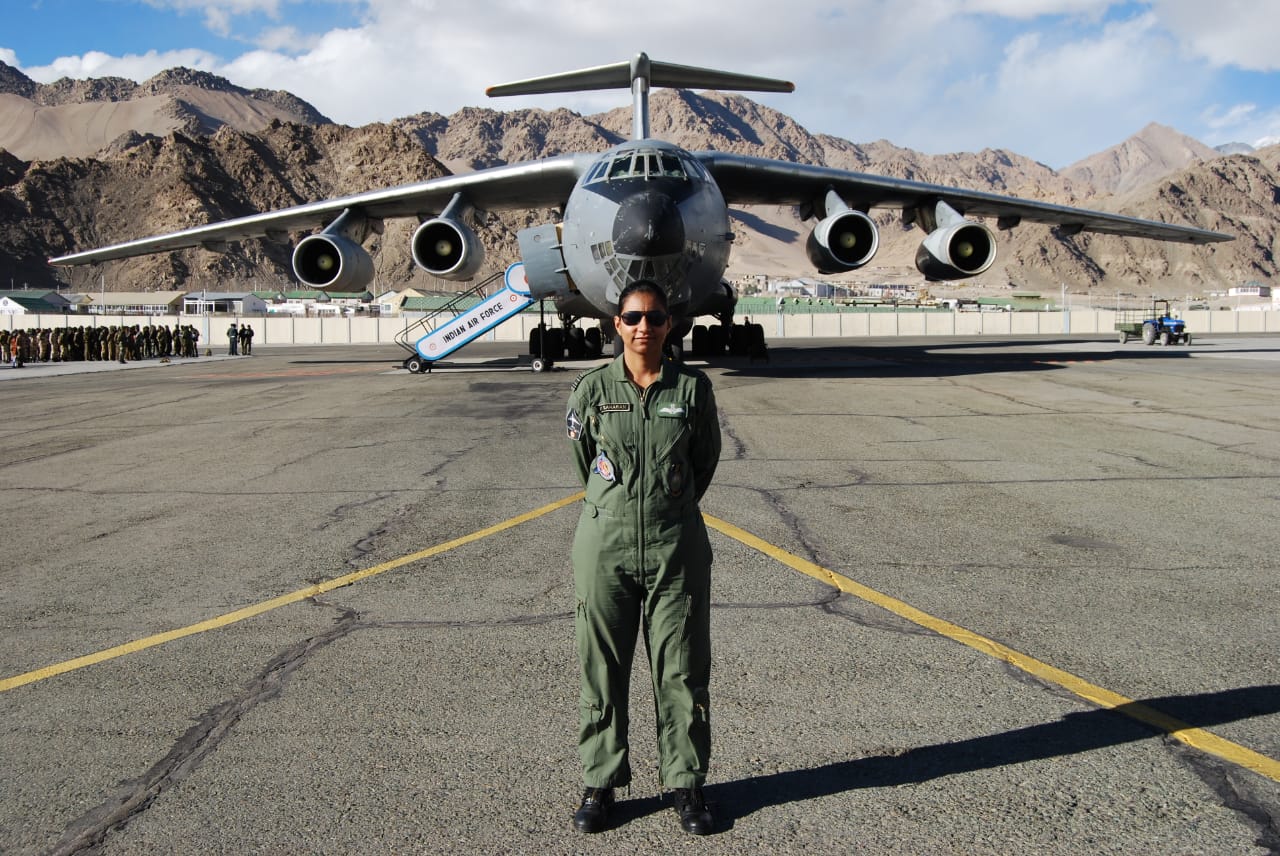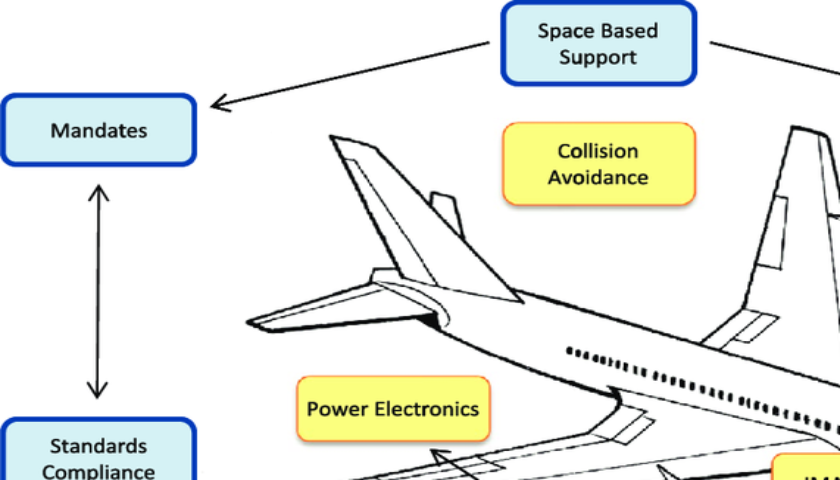“There’s something so special about a woman who dominates in a man’s world. It takes a certain grace, strength, intelligence, fearlessness, and the nerve to never take no for an answer.
Rihanna
It’s not very often one hears about India trailblazing on issues of gender equality. On the contrary, the country regularly makes headlines for all the wrong reasons when it comes to women: high rape statistics, dowry deaths, and pervasive discrimination. The data collated by the International Society of Women Airline Pilots showed that India had the highest proportion of female commercial pilots in the world at 12 percent – twice as high as in most Western countries and way above the global average of 5 percent. Today women are breaking new barriers and the glass ceilings almost as a routine. The road to genuine gender equality along with all the important nuances in between of intersecting power dynamics, dividing class inequality, crossing race superiority, and more is a long and constantly shifting one. In this article, we will meet the first women IAF pilot to fly the mighty ‘Gujraj’ Il-76 aircraft: Squadron Leader Veena Saharan (Retd).
Read on to get inspired by the military women pilot who is fondly remembered as ‘mahout’ (a mahout is an elephant rider, trainer, or keeper. Usually, a mahout starts as a boy in the family profession when he is assigned an elephant early in its life).
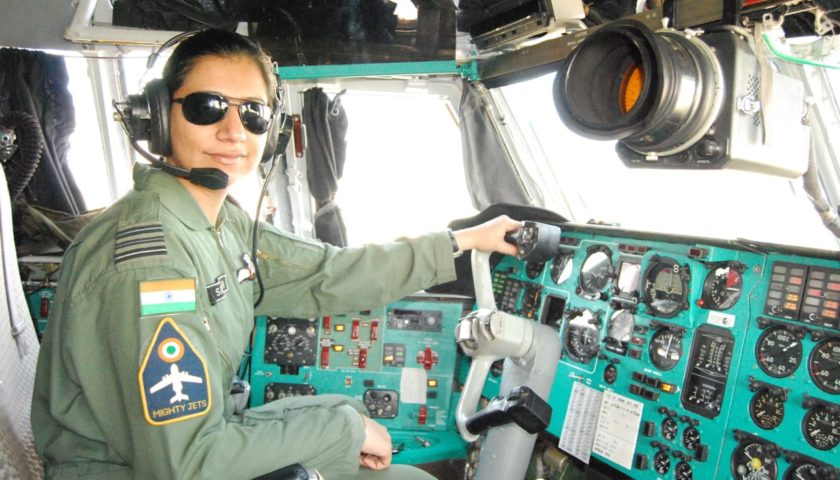
- What motivated you to join Indian Air Force (IAF)?
My maternal grandfather served in the Indian Army and fought in 1962, 1965, and 1971 wars. The attraction for the forces, perhaps, was ‘inherited’ as my father and uncles too served in the Indian Army. After 12th standard, I enrolled for BSc Physics Hons at a college in Delhi and joined the NCC (Army Wing). Apart from the regular camps, that form the routine for training, I had an opportunity to undergo a Basic mountaineering course sponsored by NCC. The desire to join the forces was being reinforced and becoming a PILOT, became my choice. The option narrowed down to Indian Air Force as, at the time, only they offered the opportunities for women to become a military pilot. I joined the Indian Air force in 2001, immediately after graduation.
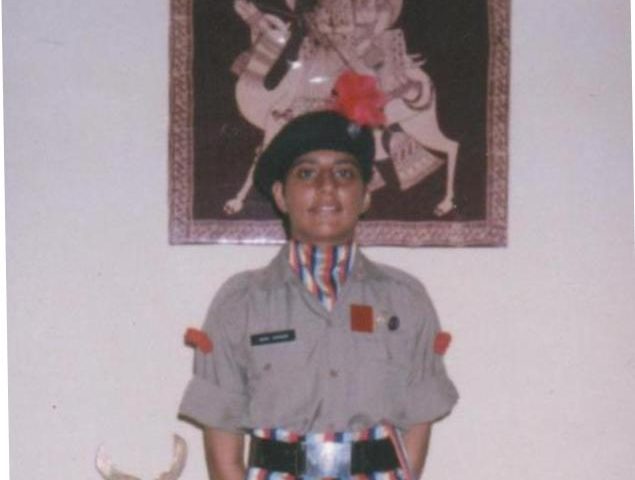
- Tell our readers something about the training that you had to undergo as a pilot?
Until 2001 the training for women pilots was 6 months less, as a result, career progression, role qualification etc were delayed and lagged behind the peers. Ours was the first women pilot batch to have the same curriculum as the direct entry men. My training started with Pre Flight Training Course- 6 months at Begumpet, Basic Flying Training- 6 months on HPT 32 at Dundigal, Advance Flying training – 1 yr DO228 (now reduced to 6 months) at Yelahanka, Transport training 6 months on An-32 at Yelehanka and then finally – a posting with an operational flying unit.
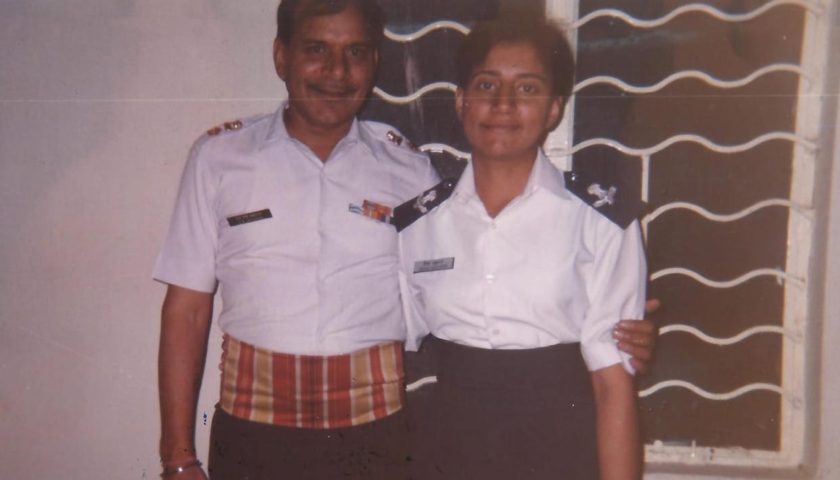
The time spent at Air Force Academy taught me the meaning of camaraderie. We had endless strengthening sessions with men and women coursemates, long cross country runs, endurance marches, training camps – the list goes on. One gets the true sense of equality when all endure the punishment together no matter who makes the mistake. I picked up so many games which I never had an opportunity to play before and secured the place among the preferred ones to win the matches for our Squadron. Swimming is a mandatory test to pass. I still remember the heartbeat skip during that 7m jump into the pool. The flying training in the military is time-bound – a lot of emphasis is given on preparation on the ground. Emergency situations and even checks and procedures are practiced so much so that we could utter it verbatim even if woken up from deep sleep. The training went on fairly well and I went on to win the coveted Fg Offr Harita Deol trophy for coming 1st in flying in women batch.
Next was another 1.5 years of training to become a transport pilot. It was a pleasant change, larger aircraft, increased range, advanced and more avionics on board. We were trained in low-level navigation, night flying, and basic transport flying. Under the able guidance of an excellent set of instructors, I earned best in flying (men and women) and best overall trophies. But I always missed those aerobatics and feeling of flying like a free bird – that could truly be realized by flying a fighter. I’m glad that the option of fighters is now open for women pilots.
- You were the first woman pilot to be inducted in the IL-76 aircraft fleet. Tell us about your journey and what was your initial reaction?
On completion of basic training, I was posted as an An-32 aircraft trained pilot to one of the elite Transport Squadron based in Chandigarh. In an operational unit, the flying task is given by the respective command HQ. We had regular air maintenance flights to the Northern sector (Leh, Thoise, and Siachen Glacier) where mountain heights range from 18000 to 26000 feet above mean sea level. The workhorse of IAF, the An-32 aircraft, frequently flew in this terrain. The weather in mountains is unforgiving; western disturbance, Clear Air Turbulence, low clouding, snow, rain, etc combination of these in close proximity of LAC (Line of Actual Control) can make it worse without warning. Pilots and Navigators have to prepare maps of the route, memorize SOPs, emergency actions, fly familiarisation flights, and then only occupy the seat of captain, co-pilot, or navigator in an aircraft. Our routine task in these valleys was time critical as we were operating at the limits of the aircraft performance. The day used to start well before the first light; we would conduct a comprehensive briefing including one practiced emergency, make small talk over a cup of tea and butter jam bread (early morning staple diet) with fellow officers and soldiers checking on each other’s well being. We used to get airborne before sunrise and fly 2-3 waves (flights) to the forward areas. Exhausted at the end of it, we would take an afternoon break and come back in the evening for organized games, perform secondary allotted duties or organize evening parties (an important aspect of the forces that fosters cohesiveness and bonding in a social setting). I’m glad I was groomed by one of the most professional organizations and got to work with the best of the bests. During my 3 years with the unit, I qualified to fly as a captain for all operational drop zones and airfields of the Northern Sector.
My second tenure was in the Eastern sector, with another prestigious Squadron. I got the opportunity to fly to remote areas of North East India. The An-32, along with helicopters, was a lifeline here. Unlike the Northern sector, the hills here were not very high but the valleys were narrow and weather unpredictable. The drop zones here have very less manoeuvring space. The airfields were very narrow, short and unprepared with part PSP (perforated steel plates) sheets part bitumen leaving no margin for error. Flying here required good handling skills. I was one of the frequently airborne pilots and flew to almost all the bases across India from here. Within a year I got cleared as captain to all the operational DZs (Drop Zones) and ALGs (Advanced Landing Grounds) of the sector. Military transport planes carry logistics supplies, troops, ammunition, armoured vehicles and tank (in the larger ones..!). Air exercises at different scales are conducted regularly to practise and improve airdrops at the time of any conflict. This demands all designated aircraft to fly in formation at low level to avoid detection by enemy radar. Qualified pilots are trained and cleared for these roles. I’m glad I could contribute to my unit’s operational readiness by clearing for all roles and attained supervisory category (BG).
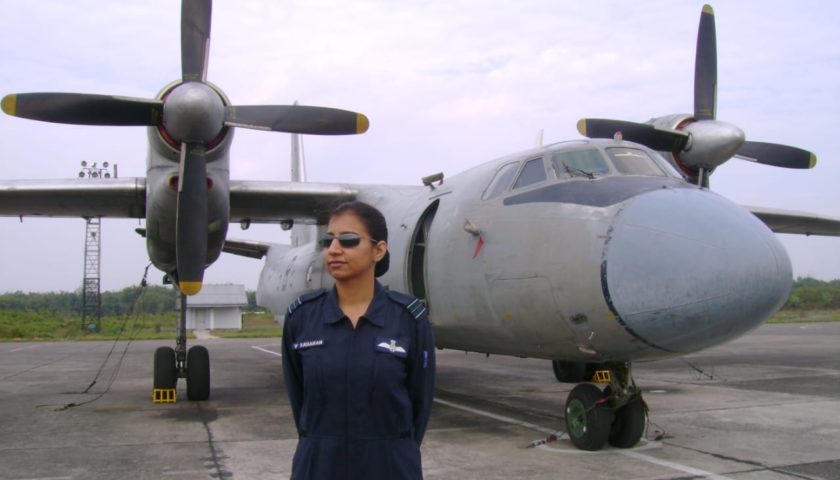
It was a Friday night and a Squadron party was going on when a fellow officer came and congratulated me. I was confused and asked, ‘why’? It was then that I was told about my transfer to an IL-76 unit. At first, I thought it to be a prank because firstly, women pilots were not given conversion on more than one type of aircraft and secondly, I had spent only a year in the squadron and postings generally did not come before 2-3 years. Finally, it became clear that I had been chosen to convert onto IL76 aircraft as the first woman pilot of IAF. IL-76 is a 4 four-engined strategic heavy-lift aircraft known as the Gajraj in India. It was unheard of Officers with such short service (men and women) as mine to be posted to this unit. It was a welcome change, I was excited, anxious, nervous…all at once.
- Moving from turboprop An-32 to turbofan Il-76 was a big jump in the performance of aircraft and technology as well. As a first woman pilot on IL-76, did you feel any additional pressure or stress to perform? Tell us about your experience and training.
I was posted to a prestigious Squadron having a glorious history of having fielded the An-12s and IL-76 aircraft. It is the only transport unit to be conferred the Battle Honours. I was welcomed to the unit just like any other officer. The first advice I got was “to fly this aircraft in this Squadron you have to be mentally and physically strong”. In Armed Forces every unit has its ethos and culture and all personnel abide by it. Now it was ‘desh ki, unit ki, aur apni izzat ka sawal‘. There was no turning back, I had to do it and do it well..! This unit had the best of the officers and soldiers on its strength and I tried to imbibe as much as I could from their vast experience on IL-76 and their exposure in international exercises, relief operations, etc.
Loads of manuals were to be read before I could even touch the aircraft. I don’t remember a time when I was without a book or notes, trying to make good of every possible minute..! There were few other very senior and experienced pilots converting onto ILs along with me. I could not afford to lag behind and hence put in all possible effort and tape upon knowledge. In IL-76 the throttles, engines, slats, flaps, and spoilers are handled by an engineer on the captain’s command from Takeoff till landing. Flying it is a classic example of CRM among flying and nonflying crew members. Just like any other heavy category aircraft, its inertia demands a rock steady alignment laterally and vertically on the approach. Our instructors would thoroughly brief us and gave pointers to improve upon and just said ‘giving up is not an option’. With so much to learn and execute, being the only woman pilot in the unit never bothered me. What more one could ask for…!
- IL-76 is a strategic heavy airlift aircraft. How much time does it take for a pilot to fully convert and become operational as a captain? What roles/missions were you qualified to operate?
In IAF, Aircrew Examination Board (AEB) visits all operational bases and conducts tests (written and flying) every year for individual pilots. Categories are awarded to pilots and other flying crew members as per their experience and performance. Post completion of approximately 500 hrs on type I upgraded to become an independent captain (BG) on IL-76. IL-76 is utilized for para-drop, heavy drop, aid to civil authorities, international air exercises. I was cleared for the para drop, low-level navigation, and high altitude (>10000 feet) Leh landings. I was given the name of ‘the woman mahout’ of GAJRAJ (Elephant) and after so much of hard work, it did feel nice. I regularly undertook forward area, passenger (IL courier), and other routine flights. I frequently interacted with the base commanders during these operations seeing a young woman IL-76 captain took a few by surprise but after the interaction, I could sense it was a pleasant one.
- Tell my readers about your most memorable moment while undertaking military flights or mission.
As a military aviator, we are trained to fly an aircraft under the worst possible conditions. This kind of training keeps the confidence and morale high. As I look back there are numerous memorable occasions. In 2005 due to heavy snowfall, Banihal pass was closed and road movements had come to a standstill we flew nonstop from 6 am till midnight under marginal weather conditions and no radar coverage to get the troops across between Srinagar and Jammu. Flights to-from Leh and Thoise were all special ones and very close to my heart we were the lifeline of Indian Army troops posted there.
- You are presently working in a commercial airline as a pilot. Military and commercial operations are very different, the job is different and the environment is different. What do you miss today from your days in the blue uniform?
After serving IAF for 10 years I joined commercial aviation. It was a pleasant experience to interact and fly with pilots of diverse backgrounds. In civil aviation the aircraft are more advanced, rules and regulations are different hence a technological gap exists. In service, I majorly flew non-ICAO registered Russian planes however with the induction of new aircraft in all three forces like C-17, C-130, B-777, Embraer, BBJ, P8I, Chinook, Apache, and Rafale etc this gap has sharply reduced. Now pilots and other crew members are getting frequent international exposure very early in service while ferrying, training, or participating in Air exercises. I cherish all my years spent in IAF I feel privileged having served in this elite organization.
- Indian Armed Forces have come a long way since it first inducted women officers in 1992. Today, all wings of the military allow women in some form of combat roles. IAF has had 13.09%. Indian Navy 6% and Indian Army 3.80% of officers by the end of 2018. Do you think these numbers could have been higher?
I believe that numbers can and should be higher. However, to realize that objective, society as a whole has to undergo a fundamental change in its outlook and accept the fact that the role of a woman in our society is not merely limited to the domain of domestic chores and responsibilities. India has had a history that highlights that women have never shied away from stepping up whenever the nation demanded it. From Razia Sultan to Rani Laxmibai to the soldiers of Rani of Jhansi Regiment of the INA led by Capt Laxmi Swaminathan, our history is replete with example of women warriors stepping up when needed. This glorious tradition needs to be encouraged. With the society backing the initiatives of the Government and the Armed Forces, I am sure these numbers can dramatically improve.
- What in your opinion can be done to increase the number of women officers in armed forces?
Like I mentioned earlier, there needs to be a concentrated effort by society, government, and the Armed forces to increase the numbers. Better public awareness campaigns, social media, mainstream media, etc can be utilized to motivate young minds. A ‘know your forces’ drive can and should be encouraged wherein women warriors can hold interactive sessions at various educational centers.
- Any message you would like to give to all the girls aspiring to join armed forces.
There are three woman officers from Armed Forces Medical Services who have earned a three-star General rank. I keenly look forward to seeing more women achieve the same and higher in other Arms. Just take the first step and give your best, for even the sky is not the limit anymore…!
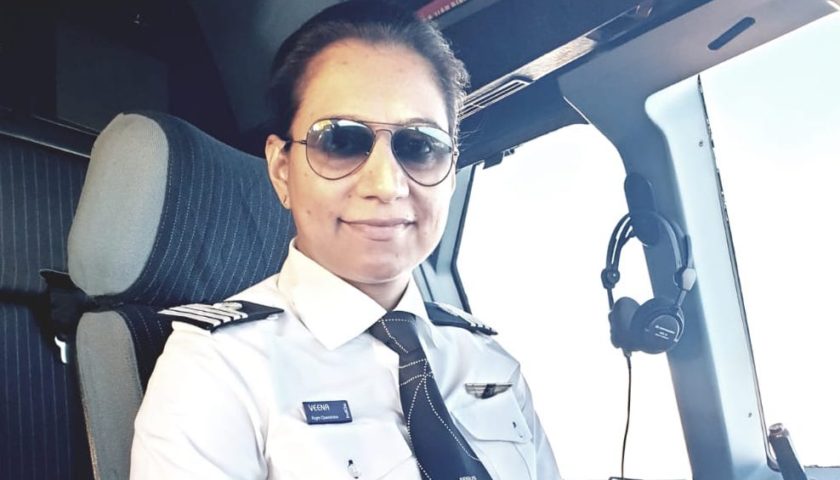
Squadron Leader Veena Saharan (Retd) is from Ratnapura, Churu, Rajasthan, presently residing at Jaipur and employed as an Airline pilot. She had the opportunity to fly 4 types of aircraft during 10 years of service with the Indian Air Force. She has more than 8000 hrs of military and civil flying experience.
Related article: Marching ahead, women officers of Indian Armed Forces. Click here to read.
Related article: My First Air Travel Experience. Click to read.
Related article: Flight Instructors. Click to read.
